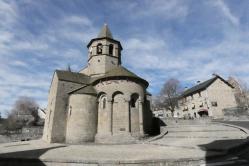The Urban V Trail
FR - Starting in Avignon and ending next spring in Saint-Flour, the Chemin Urbain V is a real paradise for hikers and pilgrims.

Villeneuve-lés-Avignon, Rochefort-du-Gard, Vers-Pont-du-Gard, Saint-Maximim, Arpaillargues, Uzès, Blauzac, Saint-Chaptes, Moussac, Brignon, Vézénobres are some of the Gard stages leading to the Cévennes, along with Anduze, Générargues, Saint-Jean-Pont-du-Gard.
Then comes Lozère with Lanuéjols, Les Salces, Mende... then Nasbinals, are among the major stops of the way.
|
The Fédération Française de Randonnée Pédestre (the French Federation of Pedestrian Trekking), founded in 1978, has approved Saint-Flour as the new and last stage of the Urban Way, 90 kms from Nasbinals. In all, there are 420 kms to cover on this route named after Pope Urban V.
|
 A historical name
A historical name
The route has been named after Pope Urban V since 2010.
Born Guillaume Grimoard in the castle of Grissac in Lozère in 1310 (a historical monument since 1984), the future pope entered the Order of Saint Benedict in 1327 and travelled between the monastery of Chirac, a chair of law at the University of Montpellier in 1342, Auxerre in 1352...
His diplomatic missions under Popes Clement VI and Innocent VI then took him on the roads of Italy before he became the 200th pope of the Catholic Church in 1362, taking over from Innocent VI...
|
Did you know that? In 2010, the association "Les Amis du Bienheureux pape Urbain V" (Friends of Blessed Pope Urban V) proposed to the departments of Lozère and Gard the route of a hiking trail that would pass through places of memory linked to the life and work of Pope Urban V. This route was approved as a GR by the French Hiking Federation (FFR) on 15 June 2014 under the name of Chemin Urbain V or GR 670.
|
On the way, 5 Unesco listed sites
First of all, the architectural jewels represented by the Palace of the Popes in Avignon, one of the greatest Gothic constructions of the Middle Ages, and the Pont du Gard (read our paper on Prosper Mérimée), both listed since 1840.
Then there are the Causses and the Cévennes National Park, listed in 2011 in the category of living evolving cultural landscapes under the heading of Mediterranean agro-pastoralism, and the Tarn canyon, which cross the Lozère and Aveyron departments, winding their way through 53 km of canyon that can be as deep as 53 m.
We should not forget to mention the transhumance, this "seasonal movement of herds along migratory routes", which has been listed as a UNESCO intangible heritage site since 2019.
What to see on the way

Among the many stops in Lozère, here is the small commune of Lanuéjols, which has a beautiful discovery in store, a Gallo-Roman mausoleum dating from the 2nd century AD, a historical monument since 1840. Built according to the plan of a mausoleum-temple, it has been the subject of several excavation campaigns in the past.

Le Monastier, or Monastier-Pin-Moriès, is home to the former Benedictine monastery of Saint-Sauveur-de-Chirac where Pope Urban V made his novitiate. Dating from the 11th century, it was classified as a historic monument in 1931.
Among the superb natural scenery of the Aubrac plateau, we can walk to the Déroc waterfall. Located on a private land, it is however possible to see it from a short distance. Situated 3 kms from Nasbinals, it dominates the glacial valley by 30 m. Namely: "a small cave, whose spectacular ceiling is formed by imposing basaltic organs. This cave would have been a refuge for brigands in ancient times" (www.aubrac-gorgesdutarn.com).

Nasbinals is part of the so-called ancient Aubrac. The village is also a stage on the way to Compostela, on the via Podiensis or voie du Puy, the GR 65.
Its Auvergne Romanesque church of Sainte-Marie (11th, 12th and 14th centuries and a historical monument since 1921) has a beautiful octagonal bell tower.
|
The tea tradition is inseparable from Nasbinals. Grouped together in an association, the tea producers of Aubrac present their products in a shop.
|

The very last stage added to the Urban V route and planned for next spring's topoguide, we arrive in Saint-Flour in the Cantal. Located 90 kms from Nasbinals, the town has been the seat of a diocese since 1317. The town, which is nicknamed the city of the wind, after a text by the Cantalien poet Camille Gandilhon Gens d'Armes, owes its name to Florus, a 5th century monk or bishop who came to evangelise the region (wikipedia).
|
An "ancient road from Languedoc" in modern times connects the Gévaudan to Saint-Flour
|
Saint-Flour has several historical monuments, starting with the Saint-Pierre cathedral (MH 1906), the Saint-Vincent church (MH 1960), the Governor's house and the Old bridge (both MH since 1946).
Thanks to J.P. Peytavin, from the Chemin de randonnée Urbain V, for the logo and the information provided.
Good to know: The tourist office of Nasbinals allows you to discover many pictures of the Phot'Aubrac photography competition.






